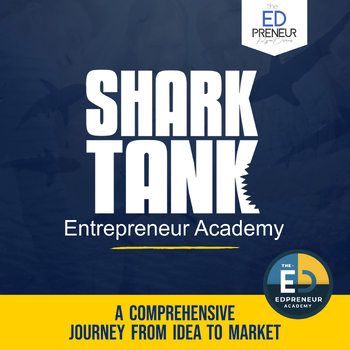Shark Tank Entrepreneurship Curriculum for Middle School 9-Week Business Course
- PDF
Description
Students Embark on a thrilling 9-week journey into the world of business with our "Shark Tank" Inspired Entrepreneurship Curriculum for Middle School. Designed as an interactive roadmap, this curriculum transforms your classroom into an entrepreneurial experience, where every project and activity brings students' business visions to life with creativity and fun.
The "Shark Tank Entrepreneurs' Academy" project is a comprehensive 9-week program designed to immerse middle school students in the world of entrepreneurship, using the "Shark Tank" TV show as a learning model. Here's this project is laid out:
- Weeks 1-2: Introduction to entrepreneurship basics and observation of entrepreneurial pitches on "Shark Tank" to understand successful presentations.
- Week 3: Brainstorming and development of business ideas, guided by personal interests or community needs.
- Week 4: Crafting a unique brand, including name and logo creation using online tools like Canva and Namelix.
- Week 5: Application of branding through the design of product mockups in Canva, enhancing understanding of visual identity.
- Week 6: Conducting market research using tools like Google Trends to understand the target audience and competition.
- Week 7: Development of a comprehensive business plan, covering marketing strategies, target audience, and financial projections.
- Week 8: Mastering social media marketing, with students creating a plan and content for their business's social media presence.
- Week 9: Refinement of business pitches, integrating elements from the business plan and branding efforts, and practicing presentation skills.
- Bonus Week 10: Final presentations in a "Shark Tank" style panel, where students pitch their business plans and receive feedback.
Resources Included:
- Activity Guides and Worksheets: Entrepreneur Episode Exploration, Business Idea Development, Business Plan Outline, Logo Design, Social Media Marketing, and Pitch Creation.
- Online Tools: Access to Canva for design, Namelix for business naming, and Google Slides/PowerPoint for presentations.
- Detailed Lesson Plans: Each week includes lesson plans that guide teachers through the implementation of the project.
Student Learning Outcomes:
- Understanding of entrepreneurship fundamentals and business planning.
- Practical experience in branding, marketing, and pitch creation.
- Enhanced research, critical thinking, and presentation skills.
Tailored for flexibility, this curriculum adapts to diverse schedules, offering a hands-on approach to entrepreneurship that fuels creativity, critical thinking, and the entrepreneurial spirit in young learners.





